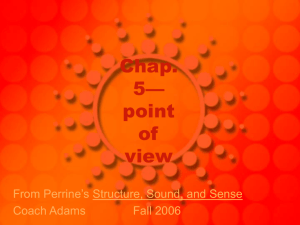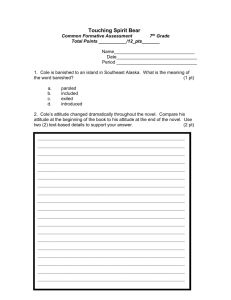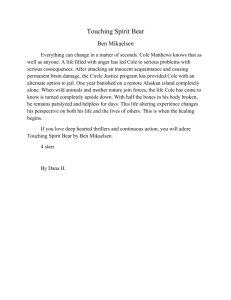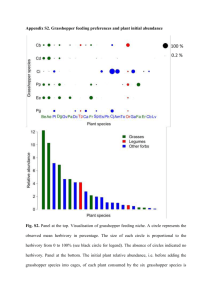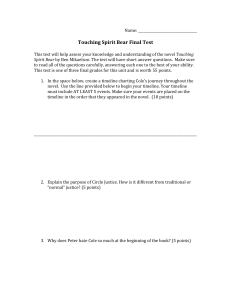Cole is attacked by the Spirit Bear!
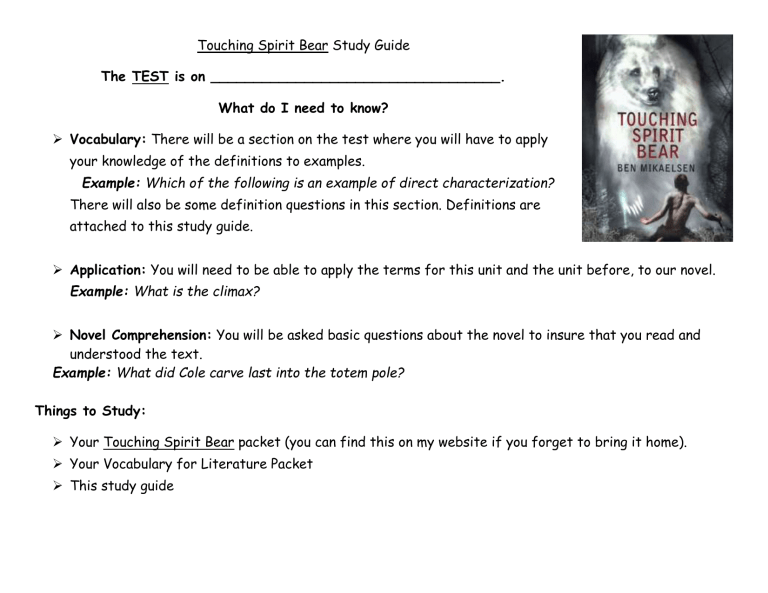
Touching Spirit Bear Study Guide
The TEST is on __________________________________.
What do I need to know?
Vocabulary: There will be a section on the test where you will have to apply your knowledge of the definitions to examples.
Example: Which of the following is an example of direct characterization?
There will also be some definition questions in this section. Definitions are attached to this study guide.
Application: You will need to be able to apply the terms for this unit and the unit before, to our novel.
Example: What is the climax?
Novel Comprehension: You will be asked basic questions about the novel to insure that you read and understood the text.
Example: What did Cole carve last into the totem pole?
Things to Study:
Your Touching Spirit Bear packet (you can find this on my website if you forget to bring it home).
Your Vocabulary for Literature Packet
This study guide
Complete sentences are not necessary, but include enough information to answer the question.
1.
Who is the protagonist? the main character in the story- Cole
2.
Is the protagonist static or dynamic? How do you know?
Dynamic- he changes he was angry and didn’t trust people and now he does.
3.
Who is the antagonist? Cole is technically his own antagonist. The issue is him vs. himself.
4.
What is the main setting? Southeastern Alaskan island
5.
What is the main conflict? The issue is Cole vs. himself.
6.
What kind of conflict is this? Internal
7.
Who are two minor characters? Cole’s parents and Peter’s parents
8.
What point of view is the story? Third person limited
9.
What’s direct characterization? when the author tells you something about the character
10.
What is indirect characterization? when the author hints about the character
11.
What is foreshadowing?
the use of clues that suggest events that haven’t happened yet. The use of this technique helps create suspense.
12.
What is flashback?
a section of a literary work that interrupts the sequence of events to relate an event from an earlier time.
13.
What is tone?
the attitude or style of expression used to write.
14.
What is mood? the general feeling in a story. It refers to the emotion or emotions a writer makes a reader feel.
Writers create atmosphere or mood by using imagery and vivid descriptions.
15.
Create a 3-4 sentence summary for the novel.
Cole beats up Peter and is sent to Circle Justice. He is sent to an island to deal with his anger and is attacked by a bear. Through this he learns to appreciate life and works to heal the wounds he caused
16.
others.
What could be a theme to the novel? Forgiveness can heal all.
17.
What was the author’s purpose? Entertain
18.
19.
What does Garvey’s lesson about the cake and hot dog have to do with Cole? What did the mean?
These lessons were about life and how each event has meaning and we should celebrate our lives.
What item does Cole throw in the ocean to show us that he is changing?
Spirit Bear hair
20.
What items does Cole carve into the totem pole and why?
Circle, bear, beaver, eagle- to heal
21.
Cole discovers that he use to have fake power. What does this mean?
He thought making people fear him gave him power, but it only left him alone.
22.
What is Cole like at the beginning of the novel? Does he change throughout the novel? Provide at least three examples. Use character traits (like brave, smart, etc.) to help answer the question.
Angry and scared and in the end he is forgiving and tries to heal others.
Complete the following chart with events from the novel:
Cole goes back to the island.
Cole is attacked by the Spirit Bear!
Initiating Event: Cole beats up Peter
Exposition: Meet Cole and are heading to the island.
Climax: Cole decides to invite
Peter to the island
Falling Action: Peter attacks Cole and they see the Spirit Bear.
Resolution: Peter and Cole finish the totem.
Author’s Purpose
Directions: Sort each of these forms of writing into the correct column.
Advertisement for Coffee
Cookbook
Short Story
Commercial for Shoes
Sitcom on TV
Movie
Short Story
Novel
Movie Trailer
Poem about love
Novel
Flyer listing reasons to attend concert
Poem about war Flyer listing facts about taking care of your teeth
To Entertain To Persuade
Political Speech
Agenda on Chalkboard
Sitcom on TV
Movie
History Textbook
To Inform
Cookbook
Flyer listing facts about taking care of your teeth
Agenda on Chalkboard
History Textbook
To Describe
Poem about love
Poem about war
Advertisement for Coffee
Commercial for Shoes
Movie Trailer
Flyer listing reasons to attend concert
Political Speech
Characterization
Read the following excerpts, which include indirect characterization, and write a sentence that states directly what the author is saying about the character.
1. As Mr. Byrd walked by families, mothers pulled their children close to their side.
Mr. Byrd is a scary man!
______________________________________________________________________________
2. Tom cried when my goldfish died.
Tom was sad and is sensitive.
Use the following direct characterizations to create a way an author might indirectly state the same idea.
1. Arnold is clumsy.
Arnold fell down the stairs carrying his drink.
______________________________________________________________________________
2. Lou is an amazing musician.
As Lou played everyone thought he played like an angel.
Determined
Responsible
Actions
Thoughts
Comments by other characters
Point of View
Read each short example and label it First Person, Third Person Limited or
Third Person Omniscient.
1. Sideways Stories from Wayside School by Louis Sachar
Leslie sat in front of Paul. She had two long, brown pigtails that reached all the way down to her waist. Paul saw those pigtails, and a terrible urge came over him. He wanted to pull a pigtail. He wanted to wrap his fist around it, feel the hair between his fingers, and just yank. He thought it would be fun to tie the pigtails together, or better yet, tie them to her chair. But most of all, he just wanted to pull one.
Third Person Limited
2.
Tuck Everlasting by Natalie Babbitt
At dawn, Mae Tuck set out on her horse for the wood at the edge of the village of Treegap. She was going there, as she did once every ten years, to meet her two sons, Miles and Jesse, and she was feeling at ease. At noon time,
Winnie Foster, whose family owned the Treegap wood, lost her patience at last and decided to think about running away.__
Third Person Omniscient.
3.
White Fang by Jack London
They spoke no more until camp was made. Henry was bending over and adding ice to the bubbling pot of beans when he was startled by the sound of a sharp snarling cry of pain from among the dogs. Henry grunted with a tone that was not sympathy, and for a quarter of an hour they sat on in silence, Henry staring at the fire, and Bill at the circle of eyes that burned in the darkness just beyond the firelight.
Third Person Omniscient.
4.
Mary Poppins by P. L. Travers, Mary Shepard
They found themselves in bed and watching, by the dim light from the night-light, the rest of Mary Poppin’s unpacking being performed. From the carpet bag she took out seven flannel nightgowns, four cotton ones, a pair of boots, a set of dominoes, two bathing-caps and a postcard album. Jane and Michael sat hugging themselves and watching. It was all so surprising that they could find nothing to say. But they knew, both of them, that something strange and wonderful had happened at Number Seventeen, Cherry-Tree Lane._
Third Person Omniscient.
_
5. The Freedom Writers Diary by The Freedom Writers with Erin Gruwell
Dear Diary, Tonight I just finished one of the books for our read-a-thon, called The Wave. This story is about a school experiment that shows how peer pressure can get out of hand. One of the main characters was a guy by the name of Robert Billing. He pressured and bullied other teenagers into acting like modern-day Nazis. The teenagers were like sheep blindly following a leader. After reading this book, I realized how teens are very gullible; getting tricked into doing things to fit in or be popular (68-69)._
First Person
Flashback, Foreshadowing and Dialogue Practice
Practice 1: The Grasshopper and the Ant
One fine summer day, Grasshopper was hopping about in the field. As he chirped and danced, he spied Ant carrying a big kernel of corn to his nest. Grasshopper watched as Ant came back, lifted another kernel, and then carried it to the nest as well. This happened repeatedly. Finally, Grasshopper asked, "Ant, why do you work so hard on such a lovely day?"
"Soon it will be winter," replied Ant. "I'm gathering food for my family. I suggest you do the same!"
"Why bother about winter?" asked Grasshopper. "There's plenty of food in the fields now!"
Ant remembered last winter and how deep snow had covered everything. There had been no way to get out of his anthill, let alone try to find food! Now, an even worse winter was predicted. "You'll feel differently when the big snow comes!" said Ant, as he shook his head and walked away.
When winter came, Grasshopper had no food. The fields were covered with deep snow. Grasshopper was very hungry and sad, knowing that Ant had food enough because he had worked hard to prepare in advance.
1. In this fable, the author uses flashback to have a. Grasshopper remembers a song he used to sing. b. Ant remembers where Grasshopper used to live. c. Ant remembers how bad last winter was. d. Grasshopper remembers where he hid seeds during the summer.
2. Which best foreshadowed what might happen in the story? a. Grasshopper hopped about in the field. b. An even worse winter was predicted. c. Ant walked away. d. Grasshopper chirped.
3. Based on the story, which do you predict could NOT happen? a. Grasshopper begs Ant for just a small bit of food. b. Ant feels sorry for Grasshopper and gives him food. c. Grasshopper digs under the snow and finds lots of food. d. Grasshopper gets weaker without any food.
4. Find an example of dialogue in the story and write it on this line: "Why bother about winter?" asked Grasshopper.
Tone: happy, joy
Context Clues: joyous glow on her face
Mood: happy
Tone: frightened
Context Clues: unknown dangers
Mood: scary
Tone: demanding
Context Clues: screamed uncontrollably
Mood: funny maybe scared
Tone: harsh and uncomfortable
Context Clues: dared to experiment
Mood: daring, mad
________________________________________________________________________________________
Know the Definitions of these AND How to apply them to the novel
Purpose in writing- The reason why you are writing. Authors have different motivating factors behind their writing. It could be to persuade, entertain, or to inform their readers. Their purpose could also be to describe a person, place, thing or event to their readers.
Characterization – the act of creating and developing character. There are two types.
Direct characterization, the author directly states a character’s traits.
Indirect characterization, the author can tell what a character looks like, does, and says, and how other characters react to him or her. The reader must draw conclusions about the character based on this indirect information.
Dialogue – a conversation between characters. It is used to develop characterization and action.
Quotation marks are used to indicate a speaker’s words.
Flashback – a section of a literary work that interrupts the sequence of events to relate an event from an earlier time.
Foreshadowing – the use of clues that suggest events that haven’t happened yet. The use of this technique helps create suspense.
First person point of view – occurs when a character tells the story. The narrator may be a major or minor character or just a witness. The reader only sees what this character sees, hears only what this character hears, knows only what this character finds out/knows, etc. The first person point of view may not be reliable.
Third person point of view – occurs when a voice outside of the story narrates. There are two types of third person:
Omniscient (all knowing; knows everything about anyone and everything), and
Limited (knows only what one character sees and thinks).
Tone- the attitude or style of expression used to write.
Mood- the general feeling in a story. It refers to the emotion or emotions a writer makes a reader feel. Writers create atmosphere or mood by using imagery and vivid descriptions.
Know how to apply these definitions to the novel. You’ve already been tested on the definitions!
Character – a person, animal, or creature who takes part in the action of a literary work.
Main characters are the most important in the story, poem, or play.
Minor characters may take part in the actions, but are not the center of attention.
Static characters have one or two traits that never change throughout the story.
Dynamic characters’ personalities change throughout the story due to things that happen in the story.
Protagonist – the main character or most important character in a story. This character often changes in some important way as a result of the story’s events.
Antagonist – the character who opposes (goes against) the main character.
Climax – the highest point of interest or suspense (part of the plot structure).
Conflict – a struggle between opposing forces. Characters in conflict form the basis of the story, novel, poem, or play. There are two kinds of conflict:
Internal (character against self)
External (character against another individual, nature or society). A story may have both.
Plot – the sequence of events in a literary work.
Exposition – the part of the work that introduces the characters, setting, and basic situation
(part of the plot structure).
Setting – the time and place of the action. It could be specific (Sterling, VA in the year 1872) or vague (present time in the south).
Initiating event – introduces the central conflict (part of the plot structure).
Rising action – all of the events that lead up to the climax that build suspense (part of the plot structure).
Falling action – actions that tie up loose ends and lead to the resolution (end) of the central conflict (part of the plot structure).
Resolution– the final events that end a work of fiction (part of the plot structure).
Theme – a central message or insight into life revealed throughout the literary work. It is a generalization about people or life that is communicated through the story. The theme may be stated directly or implied. There is usually no single correct statement of a work’s theme, although there may be incorrect ones.
